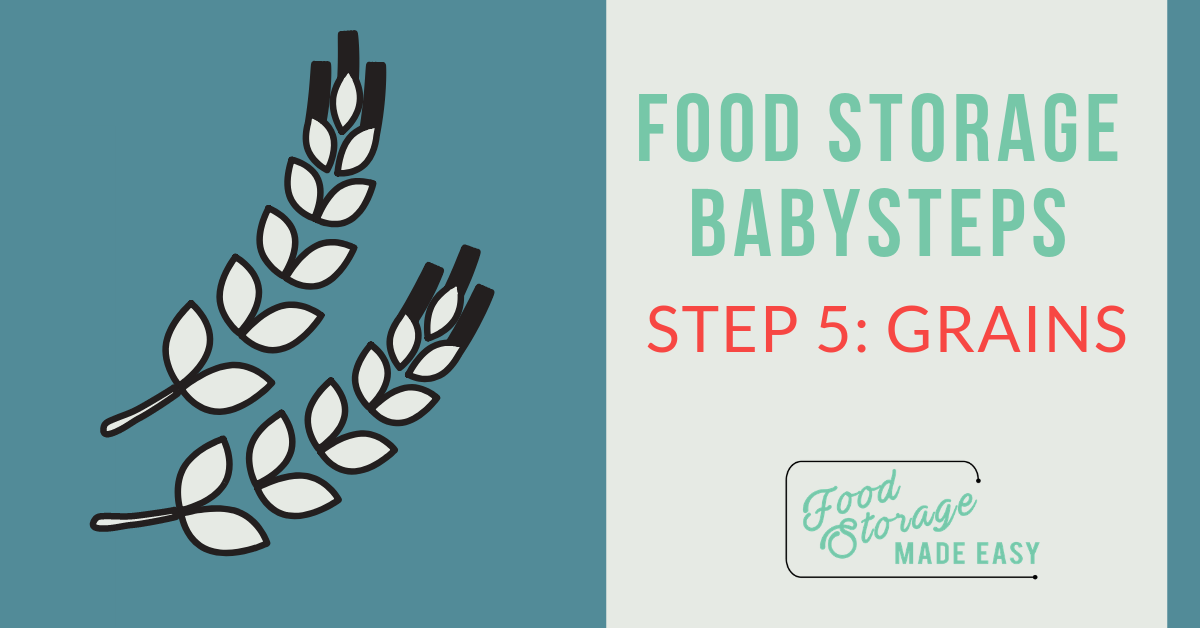
BabyStep 5 encourages you to purchase a year supply of grains and learn how to use them. Here are a few examples of grains you can store: wheat, corn, barley, oats, rice, flour, pasta, etc.
Key Points
-
- Grains are used to create the foundation of your food storage. You can make a wide variety of foods that utilize many of the different grains we recommend storing.
-
- It is recommended that half your daily grain intake be WHOLE grains due to the high nutritional value and protein levels (examples include: whole wheat, oats, brown rice, etc).
-
- Accumulate recipes that include grains. Using your grains will help you rotate through them, and get your family used to eating them. It can be hard on your digestive system to drastically change your diet in an emergency situation.
-
- Even though we talk about each grain separately, we find that WHEAT GRINDING is the major hang up for most people! Learn why NOT to be intimidated by wheat grinders by checking out our wheat grinder post and how-to video. Don’t use this as an excuse to not start this step!
- When you are ready to purchase a wheat grinder, check out our online store to view the different options we have available.
- Determine the quantities of each food item you will need to store. For more information, see BabyStep 4.
Rolled Oats
- Uses – Breakfasts, granola, cookies, filler in meat loafs or casseroles, thickener for soups/stews.
- Types – Quick rolled oats or regular rolled oats. Quick oats cook faster but regular oats retain flavor and nutrition better.
- Storage – If unopened, optimum shelf life is up to 8 years. If opened should be used within 1 year. We recommend storing large amounts in an airtight plastic container and pulling out a smaller amount every few months for your actual usage/rotation.
Wheat
- Uses – Wheat grass, appetizers, desserts, breakfast cereals, crackers, brownies, tortillas, breads, pancakes, muffins, cakes, snacks, in salads, to make vegetarian meat/protein, and any other baking item you would use flour for.
- Types – Spring or winter, hard or soft, red or white. Hard varieties have higher gluten (protein) and are better for making breads. Soft varieties have lower protein and nutrients but are better for pastries, pastas, and breakfast cereals. Red wheats are typically hard and whites are typically soft. However if you prefer the flavor of one over the other you can find soft red and hard white. Experiment with different varieties in your recipes to find out what works best for you.
- Storage – If unopened, optimum shelf life is 12 years or more. If opened will last about 3 years. However, once ground into flour, wheat loses most of its nutrients within a few days so only grind small amounts at a time. You can add oxygen absorbers, bay leaves, or dry ice to help keep critters out of your wheat.
Spaghetti or Macaroni
- Uses – As a main course, in casseroles, in soups.
- Types – You can store any type of pasta you like to use, the main ones sold in bulk are macaroni and spaghetti so they are convenient for long-term storage.
- Storage – If unopened, optimum shelf life is 8-10 years. If opened will last about 2 years. If you buy it in plastic bags we recommend transferring your pasta to airtight plastic containers for better storage.
Cornmeal
- Uses – Grits, cornbread/muffins, mush, jonnycake, hushpuppies, breading on fried items.
- Types – Steel ground or stone ground. Most common is steel ground, it has husk and germ almost all removed. Loses flavor and nutrients but has a long shelf life. This is what you will find at the grocery store. Stone ground retains more of the husk and germ but is more perishable. Cornmeal can be found in white, yellow, red, and blue varieties. Yellow and white are the most common.
- Storage – If unopened, optimum shelf life is 5 years. If opened will last about 1 year.
Enriched White Flour
- Uses – Cakes, biscuits, pie crusts, pastries, gravy, thickener, puddings.
- Types – Bleached or unbleached. Both have had their bran and germ portions removed and are “enriched” by adding back some of the lost nutrients. Bleached has been treated with chlorine, while unbleached is aged and bleached naturally by oxygen in the air.
- Storage – If unopened, optimum shelf life is 5 years. If opened will last about 6-8 months.
Enriched White Rice
- Uses – Rice pudding, cereal, casseroles, side dishes.
- Types – Bleached or unbleached. Both have had their bran and germ portions removed and are “enriched” by adding back some of the lost nutrients. Bleached has been chemically bleached while unbleached goes through a natural bleaching process.
- Storage – Shelf life is 30 years.
Pearled Barley
- Uses – Thickener in soups and stews, in sides or casseroles similar to how you would use rice.
- Types – You can buy pot barley which retains more of the nutritious germ and brand, but it has a shorter shelf life. Pearled barley is recommended for long-term food storage.
- Storage – If unopened, optimum shelf life is 8 years. If opened will last 18 months.
More Information
Where to Buy Grains
 |
 |
 |
Helpful Products
 |
WONDERMILL GRAIN MILL: An electric mill is an important tool for rotating and practicing using all of your grains, not just wheat. |
 |
WONDER JUNIOR DELUXE: A manual wheat grinder is useful for powerless emergencies and also to grind oily items like nuts and seeds. |
 |
BOSCH MIXERS: If you are planning to get into bread baking with your wheat, a Bosch mixer will be a great tool to add to your kitchen. |


 Hi there! I’m Jodi. I share my preparedness adventures via the blog and social media so you can see what I’m working on day to day.
Hi there! I’m Jodi. I share my preparedness adventures via the blog and social media so you can see what I’m working on day to day.